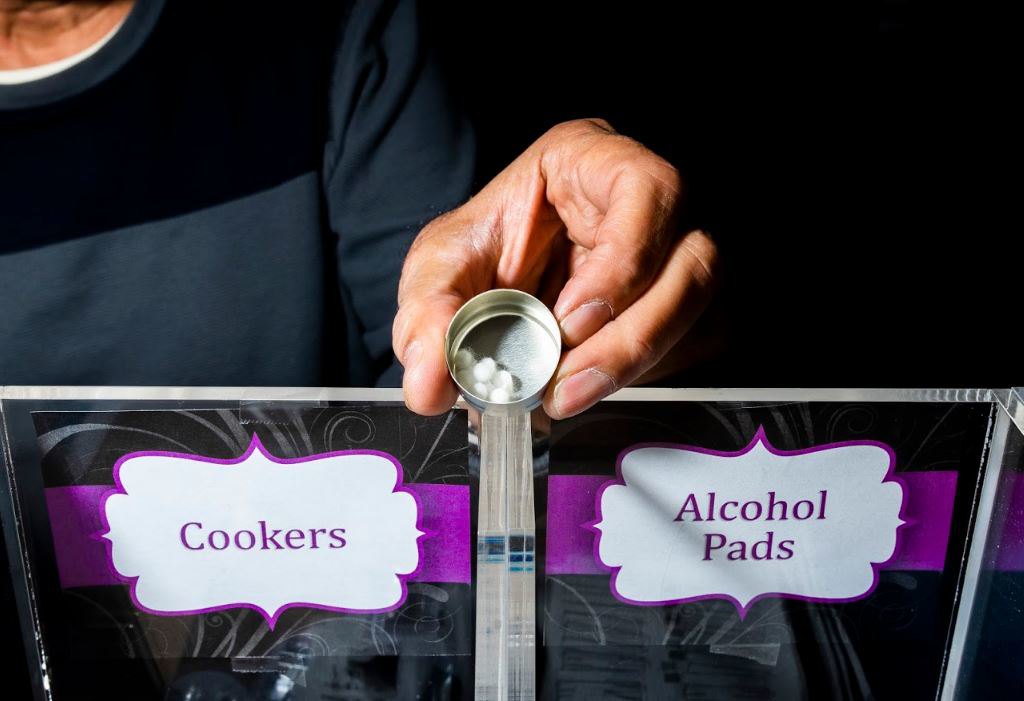Nearly hidden underneath a subway overpass, an unremarkable, two-toned brick building sits at the corner of Broadway and Van Buren St. It’s distinguishable only by the words displayed prominently on its facade: “After Hours Project, Inc.” The sounds of the J train rumbling into Kosciuszko St. and music from cranked-up car stereos seep through the building’s walls, lending a soundtrack to the otherwise quiet offices inside. This building is one of several homes of After Hours Project (AHP), which is a community-based harm reduction program that also provides mobile services after normal business hours. But that description barely scratches the surface of the work that goes on within these walls.
AHP is a syringe exchange program, a social and mental health services provider, an opioid use disorder treatment facility, and about a dozen other things that would be impressive on their own. It is all of these, but, first and foremost, it is a haven. “A lot of times, people that don’t have insurance or who are fearful of establishments won’t seek certain services,” said Fernando Soto, Executive Director of AHP. “We make them feel comfortable and make them feel that we’re here to help. And they don’t have to pay for the services.”
Founded by Soto in 2002, AHP has grown steadily over the past 17 years, expanding its services and impact on the Bushwick, Bed-Stuy, East New York, Brownsville and Ridgewood communities all the while. Most recently, the organization added a medication-assisted buprenorphine treatment program clinic, which began offering treatment five days a week in August 2018.

Buprenorphine is a medication used to help people reduce or quit the use of heroin or other opiates. According to the Substance Abuse and Mental Health Services Administration (SAMHSA), when buprenorphine is used in conjunction with counseling and behavioral therapies, it can provide a holistic approach to the treatment of opioid dependency.
Two months after opening the buprenorphine treatment clinic, AHP was awarded a SAMHSA grant for $524,670, allowing the organization to expand the clinic’s capacities. An additional physician and physician’s assistant were hired, along with a licensed social worker and two health educators. The additional staff and money allowed the clinic to take on 250 more clients, bringing the total close to 350.
In the face of a nationwide opioid epidemic, AHP’s buprenorphine treatment program has been a vital addition to the borough, where few other treatment options exist that are as accessible as AHP’s.
Opioid treatment at AHP begins when a person comes in seeking treatment or wanting to explore treatment possibilities for opioid addiction. They speak to a counselor, who helps the client develop a treatment plan that works best for them. If the client qualifies for buprenorphine treatment—a client must be showing symptoms of withdrawal to qualify —they receive the medication right away and are monitored by AHP staff.

After this first dosage of buprenorphine and a round of lab tests, AHP staff writes up the individual’s buprenorphine prescription. AHP staff then picks up the prescription and hands it directly to the client. Clients return when their prescription is up to continue receiving treatment for opioid addiction, as well as other services offered by AHP, including mental health services and sexually-transmitted infections screenings.
According to the NYC Department of Health, Brooklyn was the borough with the second highest number of overdose (OD) deaths in 2017 (the 2018 data has not yet been published). Of those overdose deaths, 54 percent involved fentanyl, which is an extremely potent synthetic opioid that is more frequently being produced illicitly and sold in combination with other drugs like heroin or cocaine. “Everything that comes in, all the drugs that come in already have fentanyl in it. It’s a lot cheaper, a lot more potent,” said Soto.
Drug users may not be aware that their supply could be cut with fentanyl, which can lead to fatal overdoses. To combat this, AHP has made overdose prevention training central to their outreach programming. The organization’s overdose prevention addresses not only how to help someone who has overdosed, but also the underlying causes of addiction and how best to support a loved one who may be using.
Education, Soto believes, is the best defense we have against the opioid epidemic. Although he admits to sometimes feeling hopeless against the problem, which is compounded by a constant need for more funding, Soto feels that New York has “attacked [the epidemic] more, and stepped up to the problem more than in other places because the city and state have become partners. And they do want to stop the epidemic.”

“Tackling the opioid epidemic plaguing our City requires cooperation at all levels of government,” Congresswoman Nydia Velázquez said in a statement congratulating AHP on receiving the SAMHSA grant. “Deploying these federal resources to a trusted local partner like the After Hours Project can be one of the most effective ways of aiding our neighbors who need help.”
Looking ahead, AHP hopes to raise enough money to convert their warehouse into a 24-hour drop-in center where people in need can seek treatment, talk to a counselor, or just do laundry and take a shower, unburdening themselves for a short while in a place that welcomes them with no caveats or expectations.
“I go to sleep at night, and I’m thinking, ‘What’s the next step?’ I know that I want to get up the next day to come to work. I want to see what we’ll do, and see success stories,” said Soto.
Follow After Hours Project on Twitter for further updates about their work.
Cover photo courtesy of Mark Davis
For more news, sign up for Bushwick Daily’s newsletter.
